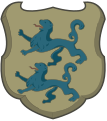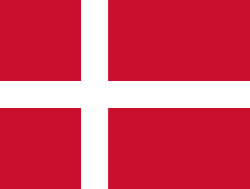Státní znak Dánska
| Dánský státní znak | |
|---|---|
 | |
| Informace | |
| Subjekty oprávněné užívat znak | |
| Přijato | 5. července 1972 |
Státní znak Dánska se třemi lvy je od roku 1959 jediný státní znak země. Znak reprezentuje celé Dánsko a je používán jako jeho národní znak. Velký resp. královský znak je užíván jako znak královny a vládnoucí dynastie.
Verze znaku
Státní znak
Státní znak tvoří zlatý štít se třemi modře zabarvenými kráčejícími lvy. Mezi nimi je devět červených srdíček. Na štít znaku je položena královská koruna. Z toho znaku vycházeli i Estonci při vytváření svého státního znaku. Tři modří kráčející lvi jsou totiž ve znaku estonského Tallinnu, který založil král Valdemar II. Vítězný. A jelikož státní znak Estonska vychází ze znaku Tallinnu je podobný státnímu znaku Dánska.[1]
Královský znak

Královský znak má čtvrcený štít pomocí kříže ze státní vlajky. V jeho prvním poli jsou tři modří kráčející lvi se zlatými korunami obklopení devíti srdíčky. V poli druhém je na modrém podkladu stříbrný beran – znak Faerských ostrovů. Ve třetím poli královského znaku je stříbrný medvěd na modrém podkladu – znak Grónska. Ve čtvrtém poli jsou dva modří kráčející lvi – znak Šlesvicka.[2] Do středu celého královského znaku je položen srdeční štítek, který zobrazuje dvě červená břevna na zlatém poli symbolizující dynastii Oldenburků
 |  |  |  | (c) McLennonSon, CC BY-SA 3.0 |
| srdeční štítek Oldenburkové | 1. pole Dánsko | 2. pole Faerské ostrovy | 3. pole Grónsko | 4. pole Šlesvicko |
Znaky ostatních členů král. rodu
Znak korunního prince Christiana je stejný jako královský znak, až na purpurovou barvu a korunu. Znak prince Joachima je stejný jako královský znak, až na půlený srdeční štítek, jehož jedna půlka zahrnuje znak dynastie Oldenburků a druhá znak hrabat de Laborde de Monpezat.
- Znak korunního prince Christiana
- Znak prince Joachima
Historie znaku
- Znak Dánska ve středověku
- Znak Šlesvicka
- Znak Wendů
- Znak Gothů
- Znak Dánska za Frederika II., kdy obsahoval znak Norska (1559–1588)
- Dánský znak (1819–1903), první verze bez Norského lva
- Dánský znak (1903–1948, Island je reprezentován sokolem, namísto dosavadní vykuchané ryby
- Dánský znak (1948–1972)
- Dánský znak (1972–2024)
- Dánský znak (od roku 2024)
Odkazy
Reference
- ↑ BROŽEK, Aleš. Lexikon vlajek a znaků zemí světa. Praha: Kartografie Praha, 2003. ISBN 80-7011-776-1. Kapitola Dánsko, s. 53.
- ↑ STEIN, Ditta. Ruce pryč od Grónska. Dánsko mění královský erb, vyslalo vzkaz Trumpovi. iDNES.cz [online]. 2025-01-07 [cit. 2025-01-07]. Dostupné online.
Související články
Externí odkazy
 Obrázky, zvuky či videa k tématu státní znak Dánska na Wikimedia Commons
Obrázky, zvuky či videa k tématu státní znak Dánska na Wikimedia Commons - Státní znak Dánska na Flags of the World
- Civicheraldry.com – Denmark, national coat of arms Archivováno 22. 4. 2009 na Wayback Machine. (anglicky)
Média použitá na této stránce
Autor: Di (they-them), Licence: CC BY-SA 4.0
Royal arms of Denmark from 2024, based on information from https://www.kongehuset.dk/en/the-monarchy-in-denmark/the-royal-symbols/the-royal-coat-of-arms/# (image).
Autor: Sodacan, Licence: CC BY-SA 3.0
Coat of Arms of Prince Joachim of Denmark
Autor: Sodacan, Licence: CC BY-SA 3.0
Royal Arms of Norway & Denmark (1559-1699)
Autor:
- Royal Arms of Norway & Denmark (1699-1819).svg: Sodacan
- De_Gothers_våben.svg: Valentinian
- derivative work: Kolomaznik (talk)
Våbenmærke
Autor: McLennonSon, Licence: CC BY-SA 4.0
Coat of arms of the King of Goths, later interpreted as the coat of arms of Jutland. Based on this and this.
Autor: User:Galico; User:Derfel73, Licence: CC BY-SA 3.0
National coat of arms of Denmark, without the crown.
Autor: Sodacan, Licence: CC BY-SA 3.0
Coat of Arms of the Danish Royal House from 1903-1948, and HM Kings Christian IX, Frederick VIII, Christian X, Frederick IX of Denmark.
Autor: Sodacan, Licence: CC BY-SA 3.0
Frederik IX of Denmark's royal arms after 1948 (also designated as the "greater coat of arms" until 1959, when its use was reserved for the monarch rather than the Danish state). Unlike the arms of his daughter, Queen Margrethe II, this arms contains insignia corresponding to the medieval titles of "King of the Wends" [lindworm] and "King of Goths" [lion and hearts] and the ducal titles relating to Holstein [nettle leaf], Stormarn [swan], Dithmarsch [knight], Lauenburg [horse's head], and Delmenhorst [cross]. The use of the preceding symbols ended in 1972 when the current monarch ascended the throne. The arms of the cross between the main quarters of the shield are curved indicating a relation to the Order of the Dannebrog. In 1972, the arms of this cross were straightened out to imitate the Danish flag rather than the royal order. Except for various changes in the third quarter of the shield, all versions of the Danish "greater coat of arms" from 1819 to 1972 have otherwise been identical. 2. What is the national coat of arms?
Autor: Sodacan, Licence: CC BY-SA 3.0
Coat of Arms of the Danish Royal House from 1819-1903, and HM Kings Frederick VI, Christian VIII, Frederick VII and Christian IX of Denmark.
(c) McLennonSon, CC BY-SA 3.0
Coat of arms of the duchy of Schleswig. Based on this.
Autor: Sodacan, Licence: CC BY-SA 3.0
Royal arms of Denmark. (1972-2024)
Autor: Sodacan, Licence: CC BY 3.0
Coat of Arms of the Crown Prince of Denmark following changes by The King of Denmark.
Autor: Samhanin, Licence: CC0
Coat of arms of the Duchy of Schleswig (1659)






























